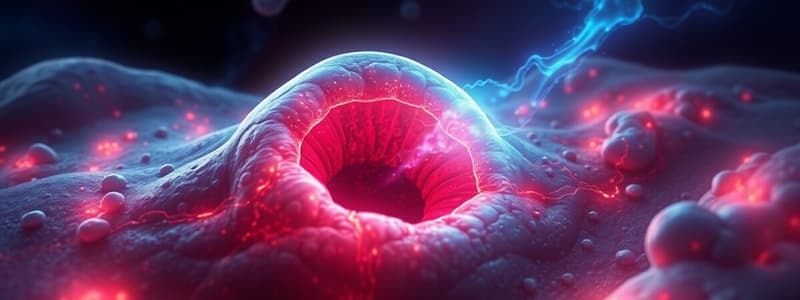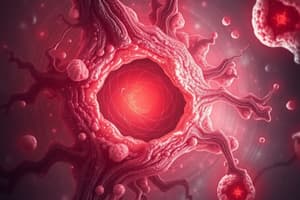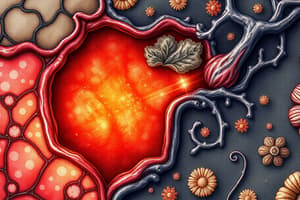Podcast
Questions and Answers
What effect does increased oxygen have on collagen deposition?
What effect does increased oxygen have on collagen deposition?
- Increases collagen deposition (correct)
- Decreases collagen deposition
- Does not affect collagen deposition
- Causes irregular collagen deposition
Which gene is associated with fibrillin production?
Which gene is associated with fibrillin production?
- FX II gene
- FBNI gene (correct)
- TPN gene
- TGF B gene
What is the potential consequence of collagen deposition exceeding degradation?
What is the potential consequence of collagen deposition exceeding degradation?
- Increased tensile strength (correct)
- Formation of normal scars
- Reduction in collagen levels
- Increased collagen degradation
Which condition is characterized by excessive collagen formation?
Which condition is characterized by excessive collagen formation?
What role does TGF B play in collagen deposition?
What role does TGF B play in collagen deposition?
What results from improper alignment of collagen fibers?
What results from improper alignment of collagen fibers?
Which factor is NOT associated with collagen deposition?
Which factor is NOT associated with collagen deposition?
What is the outcome of the collagen plateau in tissue healing?
What is the outcome of the collagen plateau in tissue healing?
Flashcards
Collagen vs. Elastin
Collagen vs. Elastin
Collagen is a protein that provides strength and structure to tissues, while elastin is another protein that gives tissues the ability to stretch and recoil.
Collagen Deposition
Collagen Deposition
The process where new collagen fibers are laid down, contributing to tissue repair, growth, and scar formation.
Collagen Degradation
Collagen Degradation
The breakdown of collagen fibers, which is a natural process in tissue turnover and can also occur in response to injury.
Collagen Plateau
Collagen Plateau
Signup and view all the flashcards
Oxygen and Collagen Deposition
Oxygen and Collagen Deposition
Signup and view all the flashcards
Keloid Scar
Keloid Scar
Signup and view all the flashcards
FBN1 Gene and Fibrillin-1
FBN1 Gene and Fibrillin-1
Signup and view all the flashcards
TGF-beta and Collagen
TGF-beta and Collagen
Signup and view all the flashcards
Fibrillin-1
Fibrillin-1
Signup and view all the flashcards
TGF-beta
TGF-beta
Signup and view all the flashcards
O2 and Collagen Deposition
O2 and Collagen Deposition
Signup and view all the flashcards
FBN1 Gene
FBN1 Gene
Signup and view all the flashcards
Study Notes
Wound Healing
- Wound healing is a complex process with overlapping phases, initiated by injury. It's categorized by characteristic cellular populations and biochemical activities.
- Hemostasis is the first stage, characterized by vasoconstriction, platelet release reaction, and platelet aggregation. It's a reversible process and doesn't require heparin.
- Platelet plug formation is the second event, initiated by exposure of subendothelial collagen to platelets. This leads to platelet aggregation, degranulation, and coagulation cascade activation.
- Fibrinolysis is the last step of hemostasis, breaking down the clot to restore blood flow.
- Inflammation follows hemostasis, involving infiltration of different inflammatory mediators like neutrophils (peak 24-48 hours).
- Proliferative phase (Days 4-12) involves fibroblast and endothelial cell invasion, tissue continuity re-establishment.
- Maturation and remodeling is the last stage, characterized by scar remodeling and reorganization of collagen.
Coagulation
- Injured blood vessels constrict and platelet plugs form.
- Coagulation cascade is activated via two pathways.
- The pathways converge, activating Factor X to Factor IIa (thrombin).
- Thrombin converts fibrinogen to fibrin, forming a stabilized clot.
- Fibrinolysis breaks down the clot, completing hemostasis.
Inflammation
- Neutrophils are the first inflammatory cells to infiltrate the wound, followed by macrophages (48-96 hours).
- Macrophages participate in wound debridement and contribute to microbial stasis.
- Lymphocytes play a role in modulating the wound environment.
Proliferation
- Fibroblasts synthesize the proteins of the matrix and collagen.
- Endothelial cells proliferate, promoting angiogenesis (new capillary formation).
- Wound contraction reduces the size of the wound.
Maturation/Remodeling
- Collagen deposition and degradation balance for wound strength.
- Epithelialization (cell proliferation from the edge) completes re-establishment of skin layers.
- Excessive scar formation (hypertrophic or keloid scars) can result and require further treatment.
Wound Healing Factors
- Local: Mechanical injury, infection, edema, ischemia, radiation exposure, foreign bodies, low oxygen, and nutrition.
- Systemic: Trauma, metabolic disease, immunosuppression, connective tissue disorders, and smoking. Age, hypoxia, and anemia/hypoperfusion also play a significant role in impacting the healing process.
Wound Healing Complications
- Chronic wounds (fail to heal within 4 weeks): Repeated trauma, poor perfusion, excessive inflammation, and secondary infections are factors.
- Biofilm formation is a common problem, especially in diabetic ulcers or chronic wounds.
- Wound contractures may occur with scars in joints.
Factors Affecting Wound Healing
- Advanced age: Impaired intrinsic physiologic changes, especially among the elderly, delay or impair healing.
- Metabolic diseases: Diabetes, and others affect healing.
- Nutrition: Impacts healing.
- Immunosuppressant drugs and treatments: Delayed healing
- Vascular disorders: Affect blood supply, vital for healing, negatively impact healing
- Other: Smoking, tissue damage, and infections increase healing time.
Wound Classification
- Acute: heals within 4 weeks.
- Chronic: takes longer than 4 weeks to heal.
- Classification by depth: Superficial, partial thickness, full thickness, and extensive injuries.
Wound Management
- Goal: Optimal wound environment for healing.
- Types of dressings: Absorbent or non absorbent, occlusive or semi-occlusive, and others.
- Treatment: Wound debridement (removing all dead tissue), wound care, maintaining a moist wound environment, and addressing secondary complications like infection.
Chronic Wounds
- Causes: Vascular compromise, chronic inflammation, infection, and autoimmune diseases.
- Types: Ischemic arterial ulcers, venous stasis ulcers, pressure ulcers, and diabetic ulcers.
Decubitus Ulcers (Pressure Ulcers)
- Etiology: Pressure exceeding blood supply to skin.
- Grading: Stage I-IV based on injury depth.
- Management: Pressure relief, wound care, and addressing secondary issues (infection, nutrition).
Nerve Injuries
- Classification: Neurapraxia (focal demyelination), axonotmesis (interruption of axonal continuity), and neurotmesis (complete transection).
- Healing: Survival of axonal cell bodies, regeneration across transected nerve to distal stump, and migration/connection of the regenerating nerve ends.
Studying That Suits You
Use AI to generate personalized quizzes and flashcards to suit your learning preferences.




